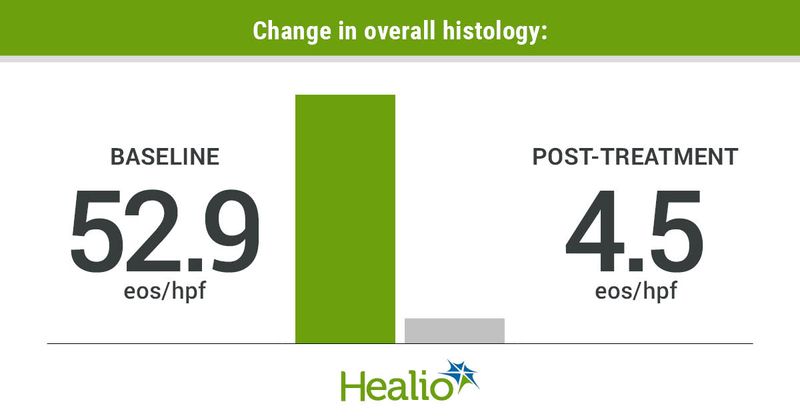Dupilumab induces eosinophilic esophagitis remission among children with atopic conditions
Dupilumab effectively induced remission of esophageal disease among children with eosinophilic esophagitis treated with the agent for atopic conditions, according to a study published in Annals of Allergy, Asthma & Immunology.
Currently, there are no approved medications for esophageal esophagitis (EoE) in the U.S. However, a previous study among adults showed that treatment with weekly dosing of dupilumab reduced peak esophageal eosinophil count.

To measure the clinical and histologic response of EoE to dupilumab, the study researchers completed a retrospective chart review of 45 patients (mean age, 15.31 years ± 3.46; boys, n = 33) at Children’s Hospital of Philadelphia and Rady Children’s Hospital-San Diego who were prescribed dupilumab (Dupixent; Sanofi Genzyme, Regeneron) for asthma, atopic dermatitis or nasal polyps and who had concomitant EoE.
Most of the patients were highly atopic, as 47% had four atopic conditions, 20% had three atopic conditions and 31% had two atopic conditions. Twenty-seven patients received dupilumab for the treatment of atopic dermatitis, 11 patients for asthma and three for chronic rhinosinusitis, with four patients receiving compassionate use of the agent for EoE.
Thirty-nine of 41 patients treated with dupilumab for an approved indication met criteria for clinical improvement of their atopic condition.
Of the 26 patients with pre- and post-endoscopy data as related to EoE symptoms or histology, 22 had more than 15 eosinophils/high power field (eos/hpf) prior to starting dupilumab. Following treatment, those 22 patients met FDA criteria for resolution of EoE with less than 6 eos/hpf.
Of the four remaining patients, one patient achieved 8 eos/hpf, two patients demonstrated a 50% reduction in eosinophil count and one patient had a 33% reduction in esophageal eosinophilia.
Overall, histology significantly improved from baseline to post-treatment (52.9 eos/hpf vs. 4.5 eos/hpf; P < .0005).
All 29 patients who tried to expand their diets or reduce their medications following treatment with dupilumab were successful, with 15 patients reducing their oral viscous steroid dose, four stopping use of proton pump inhibitors, and 10 expanding their diet without worsening symptoms or histologic exacerbations.
“Our data demonstrate that in a pediatric cohort of EoE patients, dupilumab dosed per the FDA approved schedules for asthma, atopic dermatitis or nasal polyps resulted in a meaningful improvement in EoE when used in conjunction with other EoE therapies,” the researchers wrote.
They noted that while dupilumab is not currently approved for the treatment of EoE, it is being studied at two different dosing schedules that differ from the current FDA-approved schedule of every 2 weeks for asthma, atopic dermatitis and nasal polyps.
“Because dupilumab is already approved for several allergic diseases and due to the high degree of atopic comorbidity in EoE patients, it would be important to determine if dupilumab could treat both EoE and the other allergic disease,” the researchers wrote.
